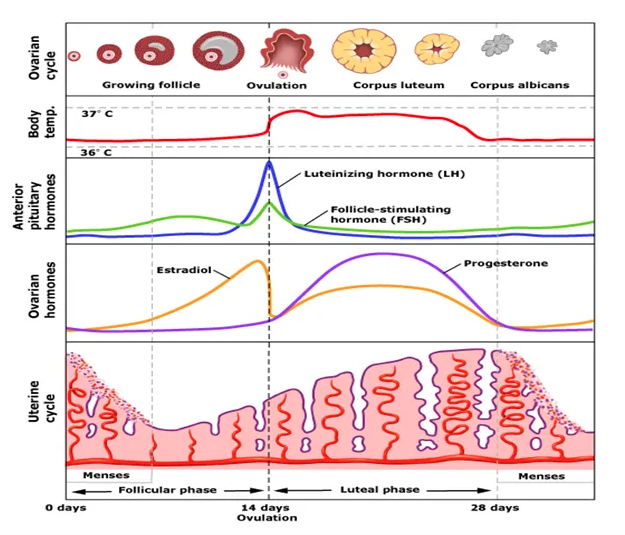FEMALES And Fitness
Understanding the menstrual cycle allows females to stay informed about reproductive health, maintain hormonal balance, optimize athletic performance, support mental and emotional well-being, and plan for nutritional and overall wellness. By learning how the female body functions, females can proactively prepare for each phase of life.
Disclaimer: Unfortunately, research on this topic and on females in general remains limited. Every female is unique, and what is considered "normal" varies from person to person. This post is based on generalizations. It's important for each female to recognize her own normal in order to use the changes in her body to her advantage.
Reproductive Phase
There are four key hormones when it comes to the female menstrual cycle. Estrogen, Progesterone, Luteinizing Hormone (LH), and Follicle Stimulating Hormone (FSH) all pay key roles in regulating the menstrual cycle. Estrogen is responsible for development of secondary sexual characteristics, bone health, heart health, skin and hair health, mood and brain function, and regulation of insulin sensitivity and glucose metabolism. Progesterone supports pregnancy and prevents additional ovulation. LH serves as an ovulation trigger, and forms the Corpus Luteum. FSH takes charge of the follicle development and estrogen production. Without a healthy balance of these four hormones, the female body cannot perform the way it was designed. Each of the four hormones play an important role in the four phases of the menstrual cycle.
Females generally begin their menstrual cycle around age 12, enter peri-menopause in their 40s, and typically reach menopause by age 51. The cycle itself lasts anywhere from 25 to 35 days, with an average of 28 days. There are various ways to break down the menstrual cycle, but I these prefer four phases: menstruation, the follicular phase, ovulation, and the luteal phase. Each phase corresponds to a season: winter, spring, summer, and fall.
The first phase, menstruation (winter), starts on day one when bleeding begins and lasts three to seven days, depending on the individual. The second phase, the follicular phase (spring), starts after bleeding ends and lasts until ovulation (summer), approximately seven days. Ovulation occurs on day 14 and lasts for 24 hours. The final and longest phase, the luteal phase (fall) lasts approximately 14 days until the cycle resets. Hormonal shifts throughout the cycle cause a variety of symptoms during the month.
Symptoms in each phase vary for each female. Menstruation involves the shedding of the uterine lining (endometrium). Common symptoms during this phase include those carried over from the luteal phase or relief from those symptoms, signs of iron deficiency, an inflammatory response, and slower recovery. To alleviate these symptoms, females can plan for shorter, strength-based workouts, allow extra recovery time, and consume iron-rich, nutrient-dense foods high in antioxidants and omega-3 fatty acids. It’s best to avoid long, strenuous workouts, processed and refined sugars, refined carbohydrates, fried foods, processed meats (e.g., sausages, hot dogs), excessive alcohol, and trans fats.
After menstruation, the body prepares for ovulation. FSH stimulates the growth of follicles, which release estrogen, prompting the uterine lining to rebuild. The spike in estrogen leads to several positive effects. Females often experience higher concentration and energy levels, increased libido, suppressed appetite, shorter recovery times, and improved adaptability. Confidence tends to increase, and higher estrogen levels can enhance overall attractiveness. During this phase, it’s important to maximize productivity, increase workout volume and frequency, and ensure proper nutrition for activity levels. As ovulation approaches, the risk of soft tissue injuries rises, so women should prioritize thorough warm-ups to prevent injury.
The third stage is ovulation. During this phase, the pituitary glad releases LH, causing the dominant follicle to rupture and release the egg. The egg then travels into the fallopian tube, where it waits for fertilization. Symptoms remain similar to those in the follicular phase, though mild abdominal pain or cramping on the side of the egg release, along with possible spotting, may occur. The basal body temperature rises, and vaginal discharge becomes clear and runny, resembling egg whites, to assist sperm in reaching the egg. If pregnancy is the goal, this is the optimal time for intercourse. If not, contraception is necessary.
*Keep in mind that although ovulation lasts only 24 hours, sperm can live for up to 72 hours, so contraception is needed before, during, and shortly after ovulation.
The final stage of the menstrual cycle is the luteal phase, often the most challenging for many females due to significant hormonal shifts. After the egg's release in ovluation, the follicle turns into the corpus luteum, which releases progesterone, causing a spike in this hormone. Estrogen drops after ovulation and gradually rises during the luteal phase. If fertilization occurs, the corpus luteum continues producing progesterone to support pregnancy. If not, the corpus luteum disintegrates, and both progesterone and estrogen levels drop. These hormonal changes trigger a range of premenstrual symptoms (PMS), particularly in the second half of the phase. Basal body temperature remains elevated, along with increased respiratory and heart rates. Additional symptoms may include brain fog, mood swings, difficulty sleeping, food cravings (due to less stable glycogen from the estrogen drop), bloating, and digestive discomfort.
Recommendations for this phase include ensuring adequate protein intake and eating smaller, more frequent meals to manage cravings. A probiotic can help with digestive issues. Prioritize important, complex, and thought-provoking tasks during the follicular stage and focus on simpler tasks in the luteal phase when concentration is more difficult. Avoid making major decisions during this phase, and wait until the follicular phase for any life-altering choices.
Each phase of the menstrual cycle serves a purpose, ultimately aimed at procreation and sustaining the human race. In recognition of October as Breast Cancer Awareness Month and Women’s Health Month, I challenge women in their reproductive years to track their menstrual cycle and symptoms to better understand what is normal for them. By identifying their normal, women can use that information proactively, rather than reacting to changes in their bodies.
Peri-menopause, menopause, and post-menopause
Peri-menopause is the transitional period leading up to menopause, when a woman's body begins to undergo changes that signal the approaching end of her reproductive years. This phase can last several years and is marked by fluctuating hormone levels, particularly estrogen and progesterone, which can cause various physical and emotional symptoms. Peri-menopause typically begins in a woman's 40s, but it can start as early as the mid-30s or as late as the early 50s. It’s almost like the body is conducting practice runs. Symptoms result from the dropping of estrogen and progesterone. Symptoms include irregular periods, hot flashes, night sweats, mood swings, sleep disturbances, vaginal dryness, decreased libido, fatigue, weight gain, and memory problems. During this time, supportive measures are key. Diet and exercise become even more important. A decrease in estrogen places a woman at increased risk for osteoporosis, cardiovascular disease, cognitive changes, and metabolism issues. It is very important for females to conduct weight bearing exercises to help promote bone health. Metabolic conditioning will help prevent cardiovascular disease. A diet rich in calcium, vitamin D, and heathy fats are also recommended. In some cases, hormone therapy may be necessary depending on the severity of symptoms. Antidepressants may also be needed depending on the extent of the cognitive and mood changes. Vaginal lubricants are also important to help prevent painful sexual intercourse.
Menopause is the stage in a woman's life when her menstrual cycles permanently stop, marking the end of her reproductive years. It is a natural biological process that typically occurs between the ages of 45 and 55, with the average age being around 51. Menopause is officially diagnosed when a woman has gone 12 consecutive months without a menstrual period. This transition is caused by the decline in the production of reproductive hormones, primarily estrogen and progesterone, by the ovaries. Symptoms align with peri-menopause and can last for several years. Treatments include diet, exercise and sleep hygiene, Hormone Replacement Therapy (HRT), non-hormonal drugs, vaginal estrogen, and alternative therapies (Yoga, acupuncture, meditation, etc.).
Post-menopause is the phase after menopause, lasting for the rest of a woman’s life. Symptoms of menopause may continue in the early post-menopausal years but typically diminish over time. It is important to get hormone levels checked to ensure they lie in an acceptable range. This becomes a woman’s new normal and their lifestyle needs to adjust to these changes.
As the saying goes, knowing is half the battle. Once you have the knowledge, the next question is how will you use it? Life can be challenging as a woman, but it also holds the reward of bringing new life into the world. Understanding your body helps you anticipate changes and effectively respond to them.
To view the presentation, click below!
References:
Bambaeichi E, Reilly T, Cable NT, Giacomoni M. The isolated and combined effects of menstrual cycle phase and time-of-day on muscle strength of eumenorrheic females. Chronobiol Int. 2004 Jul;21(4-5):645-60. doi: 10.1081/cbi-120039206. PMID: 15470960.
Enns DL, Tiidus PM. The influence of estrogen on skeletal muscle: sex matters. Sports Med. 2010 Jan 1;40(1):41-58. doi: 10.2165/11319760-000000000-00000. PMID: 20020786.
Freemas, J., & Kovacs, G. (2023, November 28). Exercise and Menstrual Cycle Phases: Know Your Body, Boost Your Health. Fempower Health. other.
Huberman, A., & Sims, S. (2024, July 22). Dr. Stacy Sims: Female-Specific Exercise & Nutrition for Health, Performance & Longevity. Huberman Lab. Podcast.
Jardim, N., & Brighten, J. (2024, April 15). Is This Normal. The Period Party. Podcast.
Jardim, N. (2021, December 20). The Four Phases of the Menstrual Cycle. The Period Party. Podcast.
Matthews, L., & Jardim, N. (2018, October 9). 127: Nicole Jardim. The BirthFit Podcast. Podcast.
Pallavi LC, D Souza UJ, Shivaprakash G. Assessment of Musculoskeletal Strength and Levels of Fatigue during Different Phases of Menstrual Cycle in Young Adults. J Clin Diagn Res. 2017 Feb;11(2):CC11-CC13. doi: 10.7860/JCDR/2017/24316.9408. Epub 2017 Feb 1. PMID: 28384857; PMCID: PMC5376807.
Romero-Moraleda B, Coso JD, Gutiérrez-Hellín J, Ruiz-Moreno C, Grgic J, Lara B. The Influence of the Menstrual Cycle on Muscle Strength and Power Performance. J Hum Kinet. 2019 Aug 21;68:123-133. doi: 10.2478/hukin-2019-0061. PMID: 31531138; PMCID: PMC6724592.

